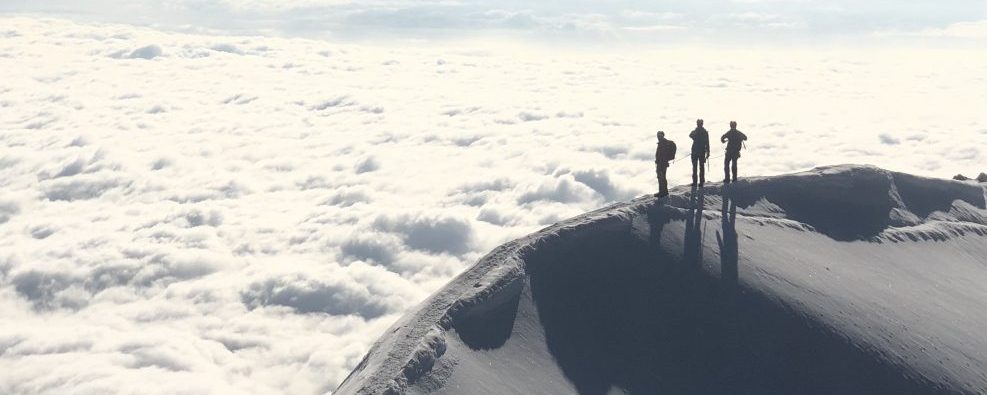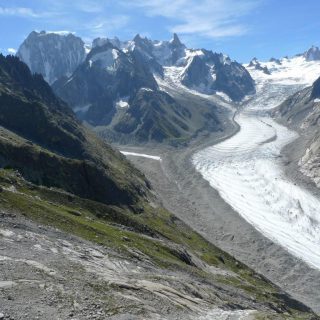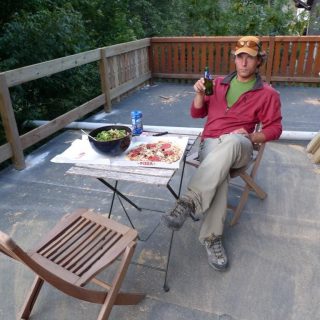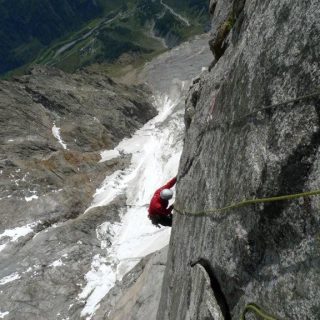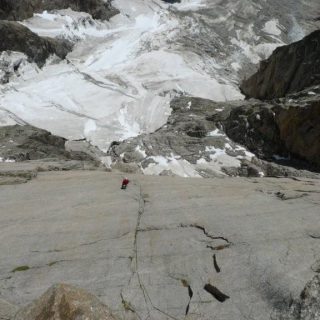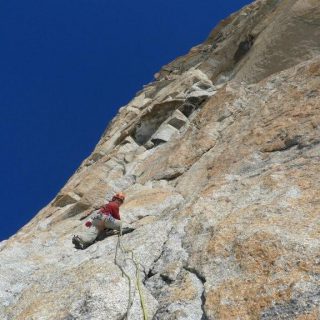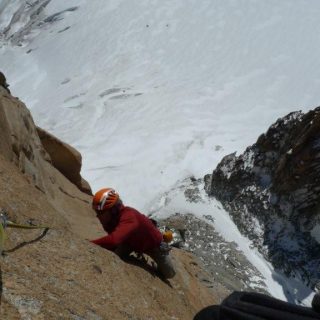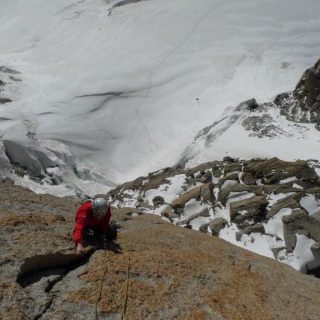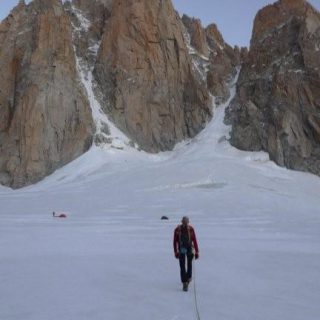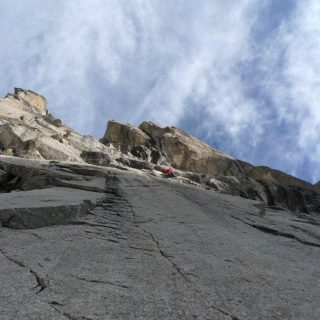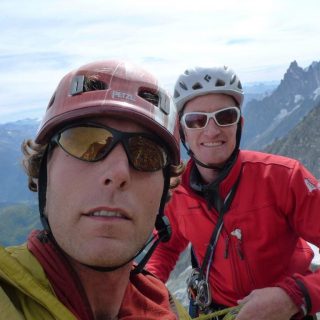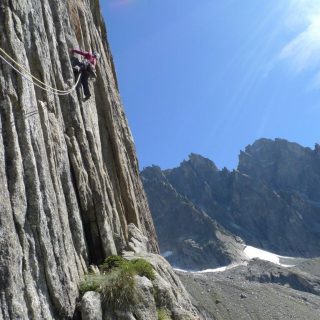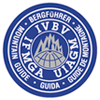Outdoor Research “Warrant” Gloves
Gloves are one of the the most important, yet least talked about pieces of gear for ice climbing. You need a pair of gloves that will keep your hands warm and still offer good dexterity. Normally I climb with a really light pair of gloves and carry a warmer pair for the belays. This year I have done a lot of days on the ice in temps hovering in the single digits and my normal lightweight gloves (OR Stormtracker) were just not cutting it! I started climbing with the Warrant and after they broke in they became my go to glove. Warm, but not too bulky, which really helps in keeping from getting pumped, and made with good quality leather so they will last more than one rappel. So, if you’re in the market for some new ice climbing gloves these are worth considering. Make sure to size them small to allow for some stretch during the break in.
The Challenges of Parenthood: A new Father’s perspective
When I first told people I was going to be a father, most people’s initial reaction was to tell me how “you’re life is going to change.” Some people even told me that my old life was “over.” For a climber and professional mountain guide this is a tough notion to grasp. I won’t lie, I loved my life prior to parenthood, and the thought of it going away was so disheartening that I denied my wife’s pregnancy for quite some time. Denial is an incredibly effective strategy and despite watching my wife’s tummy grow for nine months, I sat in the delivery room, amidst the chaos, still not totally convinced that I was going to leave the room as a new Dad and then, Olivia arrived.One thing I remember vividly from the birth was the look of bliss on my wife’s face, and the thought in my mind: okay, what now!?
Well, after two months, I may not be an authority on parenting, but I
will tell you that climbing and dealing with a new baby are more compatible than one may think… In fact, after
extensive research, I will even say that climbers and skiers have a distinct advantage over other parents in handling the challenges of a new baby. The three biggest complaints I heard from new parents was: the lack of sleep, changing diapers and dealing with the crying. These are things that climbers and skiers are well trained to handle and it is just a matter of adjusting to a new context.
Every parent I have talked to complains about the lack of sleep, but when was the last time your climbing buddy returned from their Alpine trip and whined about getting up at 2am? In the climbing world, this is simply known as is the “Alpine start.” While most people are in bed sleeping peacefully, many of us are up with our headlamps, downing espressos and setting off for the day’s adventure. That may be heading to Long’s peak, Rainier, Mont Blanc, the Matterhorn or you name it, but year round, mountain enthusiasts are up well before the general public, doing what they love. The name “dawn patrol” didn’t come about from people leaving the car at 9am. So, when your newborn starts crying at 2am for a little snack, make sure to have that
headlamp handy (we use it to have dim light in the room) and think about that trip up the Diamond later in the summer, leaving from the car at two has never sounded so easy!
The second biggest complaint I heard about parenting was about changing diapers. Here, the skiing crowd has a distinct advantage, particularly the randonnee folks. Rather than dread the diaper change, it should be embraced more like a competition. Think about a transition… you just broke trail up some slope to get fresh tracks and then some split-boarder just burned up your track planning to poach your descent. Now you can sit there and fold your skins neatly, have a sip of hot tea and watch someone else reap the rewards of all your hard work trail breaking… I don’t think so, you rip those skins, stuff them down your jacket and light it up? That’s the way to approach the diaper change: strip, fold and dispose! When babies are going through 10-12 diapers a day think about how much free time this new approach will add up to…
Lastly, everyone hates crying. Indeed it is a horrible feeling when your newborn continues to cry despite your best attempts at soothing them. But no matter how easy your baby may be or how great a parent you are, accepting some amount of crying is simply part of the game. Here again, climbers, particularly rock climbers, have an advantage. If you’re not convinced just visit your local sport crag for an afternoon and you will witness: screaming, yelling, crying, shrieking, pouting and if you’re lucky, grunting! Every belayer out there has dealt with a difficult leader at one time or another and dealing with a crying infant
is very similar. First, do your best to sooth, to help, voice encouragement, shout beta, but at some point you just have to ignore. Luckily, after a nice crying fit, most newborns seem to fall asleep as if nothing happened unlike your climbing partner who will whine the whole ride home justifying why they couldn’t send.
There is no question that having children is full of challenges and maybe it should be approached like doing a big climb.You leave the trailhead before dawn full of optimism, but you can never be entirely sure what the outcome will be.It is easy to get stressed over all the uncertainties and the dangers, but you’ll enjoy the experience much more if you just take things step by step. It’s not worth worrying about the summit only to miss the sunrise over the ridge. Over the past 18 years, I have stood on top of a lot of summits around the world, done some amazing climbs and skied some incredible snow, but little has compared to watching Olivia smile for the first time or stare back into my eyes. So while I adjust to the changes of this new life I will continue just as I have with my mountain pursuits: with enthusiasm and excitement for the adventures that lie ahead.
Another Eiger Post
Just a few months back I posted a blog and video about the Eiger North Face so if you haven’t check it out have a look. It seemed that climbing the face would satisfy my obsession about this mountain, but I think it only sparked more interest. After a busy winter, I was fortunate to climb the face not again, but two more times including guiding an ascent.
This past winter was a long and busy one with a lot of diversity. The winter began as usual with a mix of ski and ice climbing work, but then I traveled to Thailand and Jordan on a trip with Caroline. Spending a month climbing in the middle of winter is something I have never done and it provided to be quite a contrast for the season. Soon enough though I was back on the snow and spent a lot of time in huts (even on a boat) guiding ski trips in Norway, Italy, Switzerland and France. I didn’t really have any time to get out and Alpine climb, but skiing daily is good for your conditioning. I ended up with a few days off between ski trips mid-April and the weather and conditions were ripe for an Alpine climb.
Caroline and I teamed up for a climb and the conditions on the Eiger were perfect this spring. We both had climbed the face before, but doing it in a day was something we were both interested in. You can read about the climb in a post Caroline wrote so I won’t go into too much detail. The climb went well for us and it was great to move quickly on such a majestic face.
After our ascent I guided a ski descent of Mont Blanc with a friend, colleague and mentor – Martin Volken-and it seemed like this was a fitting way to cap off the season and put the snow behind me for a while. That was of course until the phone rang and a friend of Caroline’s inquired about getting a guide for the Eiger North Face.
The trouble with climbing any alpine route is that three things need to line up: good weather, good conditions and you need to be ready. So many people have traveled to Switzerland with hopes of climbing the Eiger only to be thwarted by one of the above prerequisites. When you bring guiding into the equation it only complicates matters further. My client for this ascent is a doctor in Switzerland which made logistics quite simple. She was aware of the conditions and her days off looked to coincide perfectly with the weather window. Furthermore, she has been climbing a lot this winter with many big routes under her belt so conditioning was not an issue. With everything lining up we were ready to go for an adventure of a lifetime.
Our trip began with the first train from Grindewald. While this gives you a relatively “late” start by alpine standards, you do have the advantage of day light while starting the climb. In the spring the conditions on the lower face are usually straight forward and climbing to the Difficult crack can be fast. We made great progress up until this point and then we encountered two teams who had left more than 5 hrs before us. After a little waiting we able to pass the group before the Hinterstoisser traverse thus not interrupting out rhythm. We were making good time and caught yet another team in the ice hose. Here again we were able to move past them without any delay and wouldn’t have any more resistance for the remainder of the day. The conditions on the face were good although there was some fresh snow and some sections were getting quite dry. The new snow and cool temps help mitigate rock fall, which is the biggest concern on a climb like this.
We made quick and steady progress on the first day and were planning on spending the night high on the Brittle ledges. The ramp had a couple of tricky pitches to negotiate, which proved to be the route’s crux and all of my client’s training paid off as they barley slowed us down. The beauty of climbing late in the spring is that the days are long. When we arrived at our intended bivouac there was still plenty of daylight to spare so we carried on another couple of pitches until just before the traverse of the gods. Normally, this can be one of the most aesthetic places on the route to spend a night, but here we came across a team of three who were trying the climb in a day.
This party, had either overestimated their abilities or underestimated the face, and it was clear they would not make the summit in a day. The team had brought virtually no bivy gear with them so they called a helicopter for rescue… only in Europe. However, at this time of the day the face was enveloped in clouds and it was obvious that no pilot would attempt a rescue. Furthermore, as you may imagine, a rescue here is no simple task and considering there was no immediate danger, I was a bit disturbed by the fact this team was willing to put a rescue team at risk so they could avoid an unpleasant bivouac.
In the end, no rescue came and ironically I think we suffered the unpleasant bivouac. The team of three, who had arrived before us, took the good part of the ledge to spend the night huddled together. We however, had to chop a ledge into the snow which offered sitting room only. So, despite having the necessary equipment it wasn’t one of the more pleasant night’s I’ve spent outside. Oddly enough, when morning arrived with clear skies, this team decided to carry on rather than pursue a rescue.
We made sure to start off ahead of this team and quickly made some distance on them. This part of the climb is truly majestic. The route sneaks through some improbable features crossing over some of the most well known landmarks: the Traverse of the Gods and the White Spider. We had good conditions, but things were a bit drier and a little more tenuous then on the ascent I had made two weeks before. The Exit Cracks were in good condition to start, but as we got higher conditions changed a bit. The longer days in the spring bring sun to the upper part of the mountain in the afternoon. With sun on the snow the final pitches can get quite wet on a warm day. By arriving at these pitches early in the morning they are frozen and can be covered in verglass, such was the case when we arrived. These final pitches presented one final challenge in our ascent. The pitches are not extremely difficult, but in these conditions they a bit insecure and offer little protection. Atlas, it is the Eiger after all and ascent that is too easy just wouldn’t seem fair. After negotiating the final snow field and ridge we were on our way down to catch an early afternoon train. After less than 34 hours we were back down in Grindelwald where spring was awaiting.
After doing this climb for the third time, and this time guiding it, I was struck by a couple of things. First, you can never be too prepared for a climb. My client was very fit and had put in a lot of mileage over the winter. This allowed us to move quickly and allowed her to enjoy climb rather than simply get up it. Second, this is a face that still demands respect. Today the face has been climbed in less than three hours (still mind blowing to me) and it seems that somehow this has trivialized the undertaking. But, make no mistake; it is a long climb that offers some challenging pitches. So, no matter what style to choose make sure you come ready to play ball. For me it is probably the best climb I have done and it was a privilege to help someone accomplish a goal like this.
[nggallery id=9]
[nggallery id=10]
Ski Touring Italian Style
What do you get when you cross WWI artifacts, four course meals, 12,000’ glaciated peaks, beautiful huts with Italian charm and ski touring? The Ortler-Cevedale range located in the Central Italian Alps.
This spring I guided two week long hut trips for Pro Guide Service and got to experience some of the best Italy has to offer in terms of Ski touring and hut culture. The Ortelr-Ceveldale range is home to several peaks which rise to nearly 3,800m (around 12,500ft). Nearly a hundred years ago this range was littered with barbed wire, bunkers and trenches as the Italians battled the Austo-Hungarians during World War I. While many signs of these battles are still visible (old bunkers and even cannons), soldiers have been replaced by eager skiers. Most of these peaks are glaciated with complex terrain offering a wide range of skiing objectives. Whether you prefer wide open glacier cruisers or steep exposed faces there is something for everyone.
Despite the amazing ski terrain, this represents only half of the experience on any hut trip. It is really the history, culture and, well, the food that really rounds out the adventure. In my opinion this is what really distinguishes a trip to the Ortlers from some of the other popular ski trips in the Alps. During these trips we based out of two huts and did day tours rather than skiing from hut to hut. This itinerary allows you seemingly unlimited skiing options during the days while also allowing you to relax and enjoy the huts during the evenings. Everyone has a different vision of how to enjoy huts but here are some ideas: hot showers, nice local wine, 4 course meals, a sauna or perhaps just having a conversation or chess game with a fellow skier from a neighboring country?
If you’re looking to experience a unique and adventurous hut trip in Europe a trip in the Ortles should not be overlooked. Combine this with a visit to Milan, a trip to the baths in Bormio and a night on Lake Como and you truly have a trip of a lifetime.
[nggallery id=8]
Eiger Nordwand
Eiger Nordwand from caroline george on Vimeo.
While growing up, I had heard of the infamous Eiger North Face, but I’ll confess, it was mostly just some mythical mountain that I knew nothing about. While in college I remember a friend telling me they had visited Switzerland and looked “down” on this face (presumably from the tunnel window). Being a climber I casually mentioned how I wanted to go climb that one day – still knowing nothing of what my statement entailed. I was quickly told it was impossible and I would never be able to do it… “You don’t understand”, exclaimed my friend there is rock, snow, ice, even waterfalls on this face it is just unclimbable. That was all I needed, while I nodded in agreement this was a challenge I couldn’t ignore and in my mind it was settled – I would go climb the Eiger North Face someday.
Three and a half years ago a friend and I flew to Switzerland to attempt the Eiger. We had heard the conditions were great, so we bought last minute plane tickets and set off. As it turned out, the conditions “were” great , but it had been snowing non-stop for nearly three weeks now and conditions were no longer good. While we did start the climb, our attempt was short lived. We were turned around only an hour into our climb by deep unconsolidated snow, but nonetheless, the hook had been set and for the past three and a half years this face has always occupied a place somewhere in the back of my mind.
Since my first attempt, I have read a lot of the classic litterature written about the face, seen the recent movies produced about the mountain and to top it off, even kept a link on my favorites page to the North Face webcam. I guess to some degree I was getting a little obsessive about this climb. I had spent plenty of time in Europe over the past few years, but this climb seemed to always elude me – good conditions, but no time to climb (or vise versa), bad weather, or no partner. I had even guided the Eiger on a couple of occasions via different ridges, but there was always something keeping me from a second try at the North Face.

Last week however, I got my chance. I had time off, was well acclimatized and fit after a summer of guiding, the weather looked perfect, and a call to Grindelwald revealed the conditions looked great – although nobody had been up there to confirm. I was able to convince a fellow American guide and friend of mine, Tim Connelly, to head over and have a go. I’ll admit, I wasn’t entirely optimistic and even brought an extra bag along with some sport climbing gear just in case we got shut down.

We left Chamonix at 4am with plans to catch the first train and exit just before the train enters the famous Eiger tunnel. From this position it is an easy 30 minute approach and your standing at the base of perhaps the largest face in Europe. We planned on the climbing the 1938 first ascent route in two days spending a night at the infamous “Death Bivouac”. Despite some wrong turns on our drive to Grindelwald, we managed to catch the first train at around 7:30 and we were on our way.

If I could describe the route in one word I would have to call it an Odyssey. Upon hiking to the base you are greeted with a couple of memorial plaques – not the most comforting of omens – and thus the journey begins. The route finding initially is very tricky and you meander through lines of weakness up some improbable looking terrain. Initially the rock was dry but quickly snow and ice appeared on ledges and we were forced to wear crampons. The first landmark on the route is the “Difficult Crack,” but arriving here wasn’t as straight forward as we had hoped. In fact, we did quite a bit of climbing just to arrive at this feature and some of it seemed even “more difficult”…?
From here the route finding becomes more straight forward – even more so considering there were teams in front of us putting a track in the snow – and we progressed upwards almost as if climbing back through history. We passed many of the famous pitches and landmarks including: the Hinterstoisser Traverse, First snow field,the Swallows Nest, the Ice Hose, second snow field and then finally arriving at the Death Bivouac. We enjoyed excellent conditions on the face and the climbing was never too difficult and we covered a lot of ground.
The night we spent on the face was very special for me and something I will remember for a long time. Spending a night on one of the most historic faces in the world complete with all the triumph and tragedy associated with it, was a very touching experience. The weather was perfect and we watched a great sunset, ate some soup and slept at one of the best bivy spots I have ever enjoyed.
The second day began with a traverse into the Ramp where the real climbing began. We did several pitches up this feature involving a lot of mixed climbing, awkward squeezes and some pretty scrappy ice climbing. This section of the climb reminded me of Colorado’s well known ice climb “Bird Brain Boulevard,” except this was really just the start of our day. Next we climbed up through the Brittle Ledges and Brittle crack to the notorious “Traverse of the Gods.” I had heard a lot about this section of the route and I’ll be honest I was a bit nervous about this part of the climb -a 150m snow and rock traverse which is offers tons of exposure and very little in the way of protection.

Luckily this section, while exciting, was never very difficult and allowed us relatively quick passage to the famous “white spider” and finally the exit cracks. Again, the upper part of the route has a reputation for some difficult climbing and we were not let down. The “Quartz crack,” while short, proved to be quite a challenge – rock climbing, ice climbing, dry-tooling even a little aid all used in about 20 feet – you gotta love alpine climbing.

Upon exiting the “Exit cracks” you are soon on the upper snowfields, which take you to the Mitteleggi ridge and then to the summit. The final summit ridge is quite spectacular and certainly one of the most beautiful sections of ridge found anywhere in the Alps. We spent some time on the summit taking in the view and taking in the route we had just done. The Eiger is home to so much history and after climbing the face, following in the footsteps of so many legends, it’s hard not to feel in some small way like part of the history yourself. While I will never know what it was like to climb this route in 1938, I’ll be forever humbled by the courage, determination and talent displayed by its first ascent team. This is a roue that has stood the test of time and a climb that I will never forget!



What to do with time off?
In the guiding business, summer is a busy time. The old adage “make hay while the sun shines,” is a motto that most guides I know live by. It is not uncommon to work 20-30 days straight or even more. Nonetheless, no matter what the profession, we all need a break and some time off. Some people like sandy beaches and umbrellas in their drinks, others prefer cozy cabins and reading by a fireplace. Ironically, my “get away” from guiding in the mountains usually involves going back into them…
Our trip began at the Torino Hut on the Italian side of Mont Blanc. Located at around 3,600m this hut allows quick access to the Grand Capucin one of the most acclaimed formations for rock climbing in the Massive. After a good Italian meal and restful night of sleep, we set out at sunrise intent on climbing “Voyage Selon Gulliver”, a 400m route up the heart of the formation. This route was a break through when first established in 1982 and is still said to be one of the most classic lines in the range. Thanks to the lift systems in the Alps, the approach to our route was a mere one hour stroll across the glacier. We left the hut right at dawn despite high winds and cold temps. Upon arriving at the south facing wall however, the wind had died and it sun was already warming up the orange granite.
Indeed this route was a classic. A mix of face climbing connecting brilliant crack systems takes you more or less right up the center of this magnificent feature. This “mostly free” style is something I’ve grown increasingly fond of especially during the summer when my legs seem to grow and my arms shrink. In the end, who cares, as long as you’re enjoying yourself? In the end, that is exactly what we did. We moved quickly up our route and made it back well before the last lift. Yet, had I known this route was merely a warm up for what was to come I probably would have tried to slow the day down and miss the last lift.
After our climb we enjoyed a cold beer and discussed the following day’s options. Bertrand had heard of a route on the Italian side of the range, “Etoiles Filantes” on the Tour des Jorasses. This route, located on the southern shoulder of the famous Grandes Jorasses, was likened to the Grand Capucin but much more remote and “sauvage” (wild). He figured that since I am American, the long approach and likely no crowds would be right up my alley. Maybe I’m getting soft, I’m not sure, but there is a reason why I spend so much time in the Alps. I really like to spend my time climbing rather than approaching and the lift infrastructure in the Alps makes this very easy to do. Nonetheless, after another cold adult beverage I was easy to convince and, sometimes, it is good to approach the old fashioned, by foot.
Day two didn’t begin quite as leisurely as our fist day had: our predawn start was followed by a 1700 vertical meters gain to reach the base of the route . The approach is steep and involves some interesting glacier navigation and, to top it off, one of the biggest seracs in the entire massif looms above the valley you ascend. Three and a half hours later we were at the base of the route and the real fun was only just beginning: 450 meters of granite awaited us.
The route we chose for the day was indeed a classic, but also quite sustained. This route, established by Michel Piola, perhaps one of the most prolific route setters of all time, takes a brilliant line up this majestic feature connecting crack systems via some very improbable slabs. Piola is known for his mastery of slab climbing and it seemed that he was in his prime when he created this gem. Bolts that were placed were done so quite conservatively, especially for Alps standards, that the climbing was quite engaged and committing.
Sometimes while rock climbing things just work out, the last piece of gear left on your rack is precisely the size you need, you find that key hold right in the nick of time, or in this case, I ended up with the pitches that suited me best with no premeditation (read: more gear, less scary). As it turned out on this route, Bertrand ended up with the hard slab pitches while I managed to get the hard crack pitches. Fortunately for me, I enjoy crack climbing and probably have the most experience with that, but on the other hand, nobody likes hard slab climbing. Bertrand, however, pulled off the difficult slab pitches flawlessly and our day went very smooth. We managed to get up and down the route and back down to Courmeyer in time to enjoy another nice Italian meal. After our 14 hr day and after logging nearly 900m of granite in the past two, it was time for Bertrand to go back to work, myself however, I still had two more days before I started working and the weather was still beautiful.
After a rest day, my wife joined me for one final mission. We chose a 300m route “La Reprise” on a formation known as the Flamme de Pierre noted as being a stunning crack climb. Our day began with a train ride and then required about an hour and half approach complete with descending a long series of ladders, crossing a glacier, ascending a long series of ladders, some steep hiking, an alpine meadow and a partridge in a pear tree. Once again, the granite in the Massif did not disappoint. The climbing was continuously steep and sustained up beautiful corner and crack systems with a backdrop that could not be beat. And, to top it off, there were no arguments ending in shouting or crying during our climb (okay, only someone who has climbed with their spouse will find this amusing).
We intentionally only bought one way train tickets as we were sure we wouldn’t make the last ride down. Not a big deal really, but it does add another hour and half to the descent. However, when we rappelled down to our packs, we had exactly one hour to catch the train so decided to give it a try. With a combination of running and speed descending/ascending ladders we arrived sweaty, tired but relieved to just catch the last train. A fitting end to a brilliant week of exploring some of the best granite in the range, physically exhausted but mentally refreshed to start work the following day.
